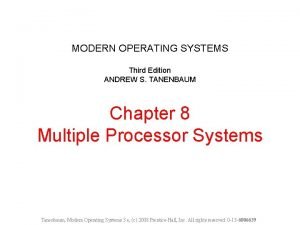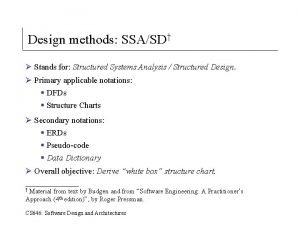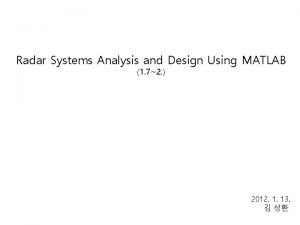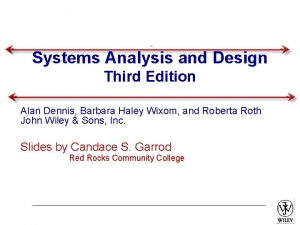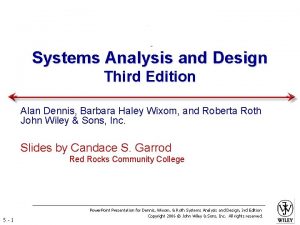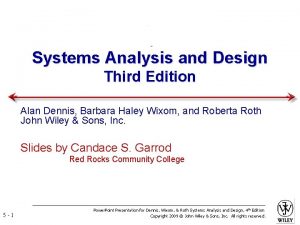Systems Analysis and Design Third Edition Alan Dennis






































































- Slides: 70

Systems Analysis and Design Third Edition Alan Dennis, Barbara Haley Wixom, and Roberta Roth John Wiley & Sons, Inc. Slides by Candace S. Garrod Red Rocks Community College 3 -1 Power. Point Presentation for Dennis, Wixom & Roth Systems Analysis and Design, 3 rd Edition Copyright 2006 © John Wiley & Sons, Inc. All rights reserved.

Planning Chapter 1 3 -2 Power. Point Presentation for Dennis, Wixom & Roth Systems Analysis and Design, 3 rd Edition Copyright 2006 © John Wiley & Sons, Inc. All rights reserved.

The Systems Development Life Cycle (SDLC) 3 -3 Power. Point Presentation for Dennis, Wixom & Roth Systems Analysis and Design, 3 rd Edition Copyright 2006 © John Wiley & Sons, Inc. All rights reserved.

The SDLC is composed of four fundamental phases: Planning Analysis Design Implementation 4 Power. Point Presentation for Dennis, Wixom, & Roth Systems Analysis and Design, 3 rd Edition Copyright 2006 © John Wiley & Sons, Inc. All rights reserved.

Each of the phases include a set of steps, which rely on techniques that produce specific document files that provide understanding about the project. 5 Power. Point Presentation for Dennis, Wixom, & Roth Systems Analysis and Design, 3 rd Edition Copyright 2006 © John Wiley & Sons, Inc. All rights reserved.

To Understand the SDLC: Each phase consists of steps that lead to specific deliverables The system evolves through gradual refinement 6 Power. Point Presentation for Dennis, Wixom, & Roth Systems Analysis and Design, 3 rd Edition Copyright 2006 © John Wiley & Sons, Inc. All rights reserved.

Phase I: Planning 7 Power. Point Presentation for Dennis, Wixom, & Roth Systems Analysis and Design, 3 rd Edition Copyright 2006 © John Wiley & Sons, Inc. All rights reserved.

This phase is the fundamental process of understanding why an information system should be built. The Planning phase will also determine how the project team will go about building the information system. The Planning phase is composed of two planning steps. 8 Power. Point Presentation for Dennis, Wixom, & Roth Systems Analysis and Design, 3 rd Edition Copyright 2006 © John Wiley & Sons, Inc. All rights reserved.

Two Planning Steps 9 Power. Point Presentation for Dennis, Wixom, & Roth Systems Analysis and Design, 3 rd Edition Copyright 2006 © John Wiley & Sons, Inc. All rights reserved.

1. During project initiation, the system’s business value to the organization is identified (How will it lower costs or increase revenues? ) 2. During project management, the project manager creates a work plan, staffs the project, and puts techniques in place to help the project team control and direct the project through the entire SDLC. 10 Power. Point Presentation for Dennis, Wixom, & Roth Systems Analysis and Design, 3 rd Edition Copyright 2006 © John Wiley & Sons, Inc. All rights reserved.

Phase II: Analysis 11 Power. Point Presentation for Dennis, Wixom, & Roth Systems Analysis and Design, 3 rd Edition Copyright 2006 © John Wiley & Sons, Inc. All rights reserved.

The analysis phase answers the questions of who will use the system, what the system will do, and where and when it will be used. During this phase the project team investigates any current system(s), identifies improvement opportunities, and develops a concept for the new system. This phase has three analysis steps. 12 Power. Point Presentation for Dennis, Wixom, & Roth Systems Analysis and Design, 3 rd Edition Copyright 2006 © John Wiley & Sons, Inc. All rights reserved.

Three Analysis Steps 1. Analysis strategy: This is developed to guide the projects team’s efforts. This includes an analysis of the current system. 2. Requirements gathering: The analysis of this information leads to the development of a concept for a new system. This concept is used to build a set of analysis models. 3. System proposal: The proposal is presented to the project sponsor and other key individuals who decide whether the project should continue to move forward. 13 Power. Point Presentation for Dennis, Wixom, & Roth Systems Analysis and Design, 3 rd Edition Copyright 2006 © John Wiley & Sons, Inc. All rights reserved.

The system proposal is the initial deliverable that describes what business requirements the new system should meet. The deliverable from this phase is both an analysis and a high-level initial design for the new system. 14 Power. Point Presentation for Dennis, Wixom, & Roth Systems Analysis and Design, 3 rd Edition Copyright 2006 © John Wiley & Sons, Inc. All rights reserved.

Phase III: Design 15 Power. Point Presentation for Dennis, Wixom, & Roth Systems Analysis and Design, 3 rd Edition Copyright 2006 © John Wiley & Sons, Inc. All rights reserved.

In this phases it is decided how the system will operate, in terms of the hardware, software, and network infrastructure; the user interface, forms, and reports that will be used; and the specific programs, databases, and files that will be needed. 16 Power. Point Presentation for Dennis, Wixom, & Roth Systems Analysis and Design, 3 rd Edition Copyright 2006 © John Wiley & Sons, Inc. All rights reserved.

Five Design Steps 1. Design Strategy: This clarifies whether the system will be developed by the company or outside the company. 2. Architecture Design: This describes the hardware, software, and network infrastructure that will be used. 3. Database and File Specifications: These documents define what and where the data will be stored. 4. Program Design: Defines what programs need to be written and what they will do. 17 Power. Point Presentation for Dennis, Wixom, & Roth Systems Analysis and Design, 3 rd Edition Copyright 2006 © John Wiley & Sons, Inc. All rights reserved.

Phase IV: Implementation 18 Power. Point Presentation for Dennis, Wixom, & Roth Systems Analysis and Design, 3 rd Edition Copyright 2006 © John Wiley & Sons, Inc. All rights reserved.

During this phase, the system is either developed or purchased (in the case of packaged software). This phase is usually the longest and most expensive part of the process. The phase has three steps. 19 Power. Point Presentation for Dennis, Wixom, & Roth Systems Analysis and Design, 3 rd Edition Copyright 2006 © John Wiley & Sons, Inc. All rights reserved.

Three Implementation Steps 20 Power. Point Presentation for Dennis, Wixom, & Roth Systems Analysis and Design, 3 rd Edition Copyright 2006 © John Wiley & Sons, Inc. All rights reserved.

System Construction: The system is built and tested to make sure it performs as designed. Installation: Prepare to support the installed system. Support Plan: Includes a postimplementation review. 21 Power. Point Presentation for Dennis, Wixom, & Roth Systems Analysis and Design, 3 rd Edition Copyright 2006 © John Wiley & Sons, Inc. All rights reserved.

Systems Development Methodologies 22 Power. Point Presentation for Dennis, Wixom, & Roth Systems Analysis and Design, 3 rd Edition Copyright 2006 © John Wiley & Sons, Inc. All rights reserved.

A methodology is a formalized approach to implementing the SDLC. The methodology will vary depending on whether the emphasis is on businesses processes or on the data that supports the business. 23 Power. Point Presentation for Dennis, Wixom, & Roth Systems Analysis and Design, 3 rd Edition Copyright 2006 © John Wiley & Sons, Inc. All rights reserved.

Process-centered Methodologies With this methodology, the focus is on defining the activities associated with the system. The concentration is on representing the system concept as a set of processes with information flowing into and out of the processes. 24 Power. Point Presentation for Dennis, Wixom, & Roth Systems Analysis and Design, 3 rd Edition Copyright 2006 © John Wiley & Sons, Inc. All rights reserved.

Data-centered Methodologies 25 Power. Point Presentation for Dennis, Wixom, & Roth Systems Analysis and Design, 3 rd Edition Copyright 2006 © John Wiley & Sons, Inc. All rights reserved.

This methodology focuses on defining the content of the data storage containers and how they are organized. Data-centered methodologies utilize data models as the core of the system concept. 26 Power. Point Presentation for Dennis, Wixom, & Roth Systems Analysis and Design, 3 rd Edition Copyright 2006 © John Wiley & Sons, Inc. All rights reserved.

Object-oriented Methodologies 27 Power. Point Presentation for Dennis, Wixom, & Roth Systems Analysis and Design, 3 rd Edition Copyright 2006 © John Wiley & Sons, Inc. All rights reserved.

This methodology attempts to balance the focus between processes and data. The Unified Modeling Language (UML) is used to describe the system concept as a collection of objects incorporating both data and processes. 28 Power. Point Presentation for Dennis, Wixom, & Roth Systems Analysis and Design, 3 rd Edition Copyright 2006 © John Wiley & Sons, Inc. All rights reserved.

Category I of the System Development Methodology: Structured Design 29 Power. Point Presentation for Dennis, Wixom, & Roth Systems Analysis and Design, 3 rd Edition Copyright 2006 © John Wiley & Sons, Inc. All rights reserved.

Structured design methodologies adopt a formal step-by-step approach to the SDLC that moves logically from one phase to the next. This design methodology introduces the use of formal modeling or diagramming techniques to describe a system’s basic business processes and follows a basic approach of two structured design categories. 30 Power. Point Presentation for Dennis, Wixom, & Roth Systems Analysis and Design, 3 rd Edition Copyright 2006 © John Wiley & Sons, Inc. All rights reserved.

Waterfall Development 31 Power. Point Presentation for Dennis, Wixom, & Roth Systems Analysis and Design, 3 rd Edition Copyright 2006 © John Wiley & Sons, Inc. All rights reserved.

With waterfall development- based methodologies, the analysts and users proceed sequentially from one phase to the next. The two key advantages of waterfall development-based methodologies are: - The system requirements are identified long before programming begins. - Changes to the requirements are minimized as the project proceeds. 32 Power. Point Presentation for Dennis, Wixom, & Roth Systems Analysis and Design, 3 rd Edition Copyright 2006 © John Wiley & Sons, Inc. All rights reserved.

The two key disadvantages of waterfall development-based methodologies are: - The design must be completely specified before programming begins. - A long time elapses between the completion of the system proposal in the analysis phase and the delivery of the system. 33 Power. Point Presentation for Dennis, Wixom, & Roth Systems Analysis and Design, 3 rd Edition Copyright 2006 © John Wiley & Sons, Inc. All rights reserved.

Waterfall Development-based Methodology 34 Power. Point Presentation for Dennis, Wixom, & Roth Systems Analysis and Design, 3 rd Edition Copyright 2006 © John Wiley & Sons, Inc. All rights reserved.

Parallel Development 35 Power. Point Presentation for Dennis, Wixom, & Roth Systems Analysis and Design, 3 rd Edition Copyright 2006 © John Wiley & Sons, Inc. All rights reserved.

This methodology attempts to address the long time interval between the analysis phase and the delivery of the system. 36 Power. Point Presentation for Dennis, Wixom, & Roth Systems Analysis and Design, 3 rd Edition Copyright 2006 © John Wiley & Sons, Inc. All rights reserved.

A general design for the entire system is performed and then the project is divided into a series of distinct subprojects. 37 Power. Point Presentation for Dennis, Wixom, & Roth Systems Analysis and Design, 3 rd Edition Copyright 2006 © John Wiley & Sons, Inc. All rights reserved.

Category II of the System Development Methodology: Rapid Application Development (RAD) 38 Power. Point Presentation for Dennis, Wixom, & Roth Systems Analysis and Design, 3 rd Edition Copyright 2006 © John Wiley & Sons, Inc. All rights reserved.

RAD-based methodologies adjust the SDLC phases to get some part of system developed quickly and into the hands of the users. Most RAD-based methodologies recommend that analysts use special techniques and computer tools to speed up the analysis, design, and implementation phases, such as CASE (computer-aided software engineering) tools. 39 Power. Point Presentation for Dennis, Wixom, & Roth Systems Analysis and Design, 3 rd Edition Copyright 2006 © John Wiley & Sons, Inc. All rights reserved.

One possible subtle problem with RAD-based methodologies is managing user expectations. 40 Power. Point Presentation for Dennis, Wixom, & Roth Systems Analysis and Design, 3 rd Edition Copyright 2006 © John Wiley & Sons, Inc. All rights reserved.

Phased Development 41 Power. Point Presentation for Dennis, Wixom, & Roth Systems Analysis and Design, 3 rd Edition Copyright 2006 © John Wiley & Sons, Inc. All rights reserved.

This methodology breaks the overall system into a series of versions that are developed sequentially. The team categorizes the requirements into a series of versions, then the most important and fundamental requirements are bundled into the first version of the system. The analysis phase then leads into design and implementation; however, only with the set of requirements identified for version 1. As each version is completed, the team begins work on a new version. 42 Power. Point Presentation for Dennis, Wixom, & Roth Systems Analysis and Design, 3 rd Edition Copyright 2006 © John Wiley & Sons, Inc. All rights reserved.

Phased Development-based Methodology 43 Power. Point Presentation for Dennis, Wixom, & Roth Systems Analysis and Design, 3 rd Edition Copyright 2006 © John Wiley & Sons, Inc. All rights reserved.

Prototyping 44 Power. Point Presentation for Dennis, Wixom, & Roth Systems Analysis and Design, 3 rd Edition Copyright 2006 © John Wiley & Sons, Inc. All rights reserved.

Prototyping-based methodologies perform the analysis, design and implementation phases concurrently. All three phases are performed repeatedly in a cycle until the system is completed. A prototype is a smaller version of the system with a minimal amount of features. 45 Power. Point Presentation for Dennis, Wixom, & Roth Systems Analysis and Design, 3 rd Edition Copyright 2006 © John Wiley & Sons, Inc. All rights reserved.

Prototyping-based Methodology 46 Power. Point Presentation for Dennis, Wixom, & Roth Systems Analysis and Design, 3 rd Edition Copyright 2006 © John Wiley & Sons, Inc. All rights reserved.

Advantage: Provides a system for the users to interact with, even if it is not initially ready for use. Disadvantage: Often the prototype undergoes such significant changes that many initial design decisions prove to be poor ones. 47 Power. Point Presentation for Dennis, Wixom, & Roth Systems Analysis and Design, 3 rd Edition Copyright 2006 © John Wiley & Sons, Inc. All rights reserved.

Throwaway Prototyping 48 Power. Point Presentation for Dennis, Wixom, & Roth Systems Analysis and Design, 3 rd Edition Copyright 2006 © John Wiley & Sons, Inc. All rights reserved.

Throwaway prototyping methodologies are similar to prototyping based methodologies. The main difference is that throwaway prototyping IS completed during a different point in the SDLC. Has relatively thorough analysis phase. 49 Power. Point Presentation for Dennis, Wixom, & Roth Systems Analysis and Design, 3 rd Edition Copyright 2006 © John Wiley & Sons, Inc. All rights reserved.

Throwaway Prototyping-based Methodology 50 Power. Point Presentation for Dennis, Wixom, & Roth Systems Analysis and Design, 3 rd Edition Copyright 2006 © John Wiley & Sons, Inc. All rights reserved.

Category III of the System Development Methodology: Agile Development 51 Power. Point Presentation for Dennis, Wixom, & Roth Systems Analysis and Design, 3 rd Edition Copyright 2006 © John Wiley & Sons, Inc. All rights reserved.

This category focuses on streamlining the SDLC by eliminating much of the modeling and documentation overhead and the time spent on those tasks. Projects emphasize simple, iterative application development. This category uses extreme programming, which is described next. 52 Power. Point Presentation for Dennis, Wixom, & Roth Systems Analysis and Design, 3 rd Edition Copyright 2006 © John Wiley & Sons, Inc. All rights reserved.

Extreme Programming (XP) 53 Power. Point Presentation for Dennis, Wixom, & Roth Systems Analysis and Design, 3 rd Edition Copyright 2006 © John Wiley & Sons, Inc. All rights reserved.

Extreme Programming (XP) was founded on four core values: Communication Simplicity Feedback Courage 54 Power. Point Presentation for Dennis, Wixom, & Roth Systems Analysis and Design, 3 rd Edition Copyright 2006 © John Wiley & Sons, Inc. All rights reserved.

Key principles of XP include: Continuous testing Simple coding Close interaction with the end users to build systems very quickly 55 Power. Point Presentation for Dennis, Wixom, & Roth Systems Analysis and Design, 3 rd Edition Copyright 2006 © John Wiley & Sons, Inc. All rights reserved.

An Extreme Programming-based Methodology 56 Power. Point Presentation for Dennis, Wixom, & Roth Systems Analysis and Design, 3 rd Edition Copyright 2006 © John Wiley & Sons, Inc. All rights reserved.

Selecting the Appropriate Development Methodology 57 Power. Point Presentation for Dennis, Wixom, & Roth Systems Analysis and Design, 3 rd Edition Copyright 2006 © John Wiley & Sons, Inc. All rights reserved.

Selecting a methodology is not simple, as no one methodology is always best. Many organizations have their own standards. The next figure summarizes some important methodology selection criteria. 58 Power. Point Presentation for Dennis, Wixom, & Roth Systems Analysis and Design, 3 rd Edition Copyright 2006 © John Wiley & Sons, Inc. All rights reserved.

Criteria for Selecting a Methodology 59 Power. Point Presentation for Dennis, Wixom, & Roth Systems Analysis and Design, 3 rd Edition Copyright 2006 © John Wiley & Sons, Inc. All rights reserved.

Clarity of User Requirements RAD methodologies of prototyping and throwaway prototyping are usually more appropriate when user requirements are unclear as they provide prototypes for users to interact with early in the SDLC. 60 Power. Point Presentation for Dennis, Wixom, & Roth Systems Analysis and Design, 3 rd Edition Copyright 2006 © John Wiley & Sons, Inc. All rights reserved.

Familiarity with Technology If the system is designed without some familiarity with the base technology, risks increase because the tools may not be capable of doing what is needed. 61 Power. Point Presentation for Dennis, Wixom, & Roth Systems Analysis and Design, 3 rd Edition Copyright 2006 © John Wiley & Sons, Inc. All rights reserved.

System Complexity Complex systems require careful and detailed analysis and design. Project teams who follow phased development-based methodologies tend to devote less attention to the analysis of the complete problem domain than they might if they were using other methodologies. 62 Power. Point Presentation for Dennis, Wixom, & Roth Systems Analysis and Design, 3 rd Edition Copyright 2006 © John Wiley & Sons, Inc. All rights reserved.

System Reliability System reliability is usually an important factor in system development. Throwaway prototyping-based methodologies are most appropriate when system reliability is a high priority. Prototyping-based methodologies are generally not a good choice as they lack careful analysis and design phases. 63 Power. Point Presentation for Dennis, Wixom, & Roth Systems Analysis and Design, 3 rd Edition Copyright 2006 © John Wiley & Sons, Inc. All rights reserved.

Short Time Schedules RAD-based methodologies are well suited for projects with short time schedules as they increase speed. Waterfall-based methodologies are the worst choice when time is essential as they do not allow for easy schedule changes. 64 Power. Point Presentation for Dennis, Wixom, & Roth Systems Analysis and Design, 3 rd Edition Copyright 2006 © John Wiley & Sons, Inc. All rights reserved.

Schedule Visibility RAD-based methodologies move many of the critical design decisions earlier in the project; consequently, this helps project managers recognize and address risk factors and keep expectations high. 65 Power. Point Presentation for Dennis, Wixom, & Roth Systems Analysis and Design, 3 rd Edition Copyright 2006 © John Wiley & Sons, Inc. All rights reserved.

Project Team Skills and Roles Projects should consist of a variety of skilled individuals in order for a system to be successful. Six major skill sets an analyst should have include: Technical Business Analytical Interpersonal Management Ethical 66 Power. Point Presentation for Dennis, Wixom, & Roth Systems Analysis and Design, 3 rd Edition Copyright 2006 © John Wiley & Sons, Inc. All rights reserved.

Categories of Analysts Business Analyst Systems Analyst Infrastructure Analyst Change Management Analyst Project Manager 67 Power. Point Presentation for Dennis, Wixom, & Roth Systems Analysis and Design, 3 rd Edition Copyright 2006 © John Wiley & Sons, Inc. All rights reserved.

Project Team Roles 68 Power. Point Presentation for Dennis, Wixom, & Roth Systems Analysis and Design, 3 rd Edition Copyright 2006 © John Wiley & Sons, Inc. All rights reserved.

Summary The Systems Development Lifecycle consists of four stages: Planning, Analysis, Design, and Implementation There are six major development methodologies: the waterfall method, the parallel development method, the phased development method, system prototyping, design prototyping, and agile development. There are five major team roles: business analyst, systems analyst, infrastructure analyst, change management analyst and project manager. 69 Power. Point Presentation for Dennis, Wixom, & Roth Systems Analysis and Design, 3 rd Edition Copyright 2006 © John Wiley & Sons, Inc. All rights reserved.

Copyright © 2006 John Wiley & Sons, Inc. All rights reserved. Reproduction or translation of this work beyond that permitted in Section 117 of the 1976 United States Copyright Act without the express written permission of the copyright owner is unlawful. Request for further information should be addressed to the Permissions Department, John Wiley & Sons, Inc. The purchaser may make back-up copies for his/her own use only and not for redistribution or resale. The Publisher assumes no responsibility for errors, omissions, or damages, caused by the use of these programs or from the use of the information contained herein. 70 Power. Point Presentation for Dennis, Wixom, & Roth Systems Analysis and Design, 3 rd Edition Copyright 2006 © John Wiley & Sons, Inc. All rights reserved.
 System analysis and design alan dennis
System analysis and design alan dennis Systems analysis and design alan dennis
Systems analysis and design alan dennis Systems analysis and design alan dennis
Systems analysis and design alan dennis Systems analysis and design alan dennis
Systems analysis and design alan dennis Systems analysis and design alan dennis
Systems analysis and design alan dennis Systems analysis and design alan dennis
Systems analysis and design alan dennis Systems analysis and design alan dennis
Systems analysis and design alan dennis Systems analysis and design alan dennis
Systems analysis and design alan dennis Systems analysis and design alan dennis
Systems analysis and design alan dennis Systems analysis and design alan dennis
Systems analysis and design alan dennis Systems analysis and design alan dennis
Systems analysis and design alan dennis Systems analysis and design alan dennis
Systems analysis and design alan dennis System analysis and design alan dennis
System analysis and design alan dennis Case tools are limited to systems analysis.
Case tools are limited to systems analysis. Modern systems analysis and design 7th edition
Modern systems analysis and design 7th edition Modern operating systems tanenbaum
Modern operating systems tanenbaum Advanced engineering mathematics dennis g zill 4th edition
Advanced engineering mathematics dennis g zill 4th edition Forward and backward caries definition
Forward and backward caries definition Mount and hume classification
Mount and hume classification Determining human information requirements
Determining human information requirements Principles of economics oxford fajar
Principles of economics oxford fajar Organic chemistry david klein 3rd edition
Organic chemistry david klein 3rd edition Organic chemistry third edition david klein
Organic chemistry third edition david klein Business mathematics third edition
Business mathematics third edition Fundamentals of corporate finance third canadian edition
Fundamentals of corporate finance third canadian edition Fundamentals of corporate finance 3rd canadian edition
Fundamentals of corporate finance 3rd canadian edition Lifespan development third edition
Lifespan development third edition Lifespan development third edition
Lifespan development third edition Essential cell biology chapter 1
Essential cell biology chapter 1 The practice of statistics third edition
The practice of statistics third edition Using mis (10th edition) 10th edition
Using mis (10th edition) 10th edition Chapter 1
Chapter 1 Systems analysis & design in an age of options pdf
Systems analysis & design in an age of options pdf Systems analysis and design in a changing world
Systems analysis and design in a changing world Systems analysis and design in a changing world
Systems analysis and design in a changing world System analysis and design in a changing world
System analysis and design in a changing world System analysis and design
System analysis and design Structured systems analysis and design methodology
Structured systems analysis and design methodology Modern systems analysis and design
Modern systems analysis and design Kendall and kendall system analysis and design
Kendall and kendall system analysis and design Structured systems analysis and design method
Structured systems analysis and design method Radar systems analysis and design using matlab
Radar systems analysis and design using matlab Object-oriented systems analysis and design using uml
Object-oriented systems analysis and design using uml A modern approach to systems analysis and design
A modern approach to systems analysis and design Patched up prototype
Patched up prototype System analysis and design in a changing world
System analysis and design in a changing world Systems analysis and design in a changing world
Systems analysis and design in a changing world Systems analysis and design in a changing world
Systems analysis and design in a changing world Ssadm
Ssadm Essentials of systems analysis and design
Essentials of systems analysis and design Systems analysis and design in a changing world
Systems analysis and design in a changing world Ssasd
Ssasd Event table system analysis design
Event table system analysis design Systems analysis and design in a changing world
Systems analysis and design in a changing world Radar system analysis and design using matlab
Radar system analysis and design using matlab System analysis and design kendall
System analysis and design kendall User interface input and output design
User interface input and output design Expert systems: principles and programming, fourth edition
Expert systems: principles and programming, fourth edition Tcsim
Tcsim User interface design in system analysis and design
User interface design in system analysis and design Dialogue design
Dialogue design Structured analysis approach
Structured analysis approach Fact finding in system analysis and design
Fact finding in system analysis and design Candidate system in system analysis and design
Candidate system in system analysis and design Principles of electronic communication systems 3rd edition
Principles of electronic communication systems 3rd edition Introduction to radar systems skolnik
Introduction to radar systems skolnik Introduction to information systems 6th edition
Introduction to information systems 6th edition Fundamentals of information systems 9th edition
Fundamentals of information systems 9th edition Fundamentals of information systems 9th edition
Fundamentals of information systems 9th edition Introduction to information systems 6th edition
Introduction to information systems 6th edition Management information systems 16th edition
Management information systems 16th edition















